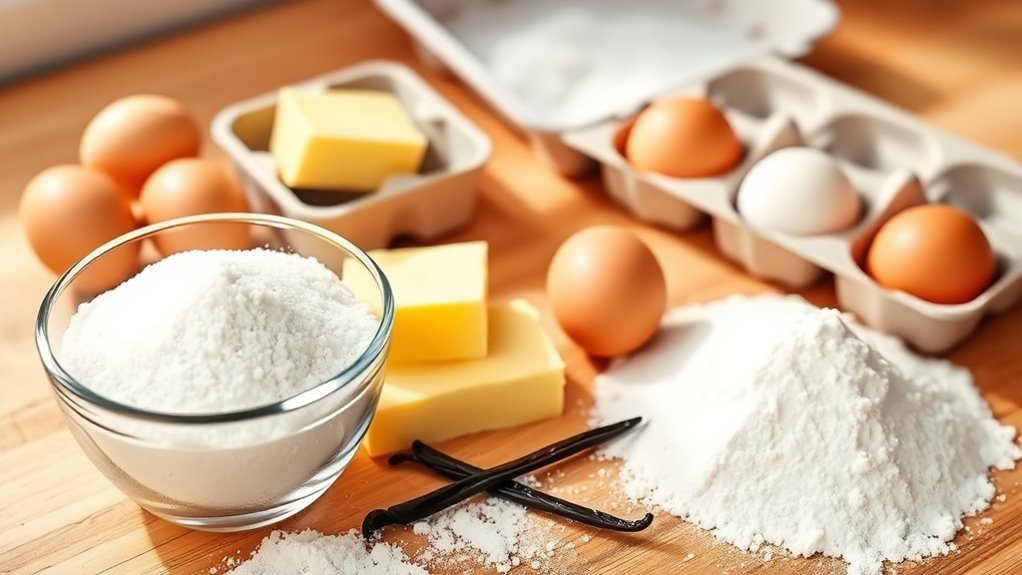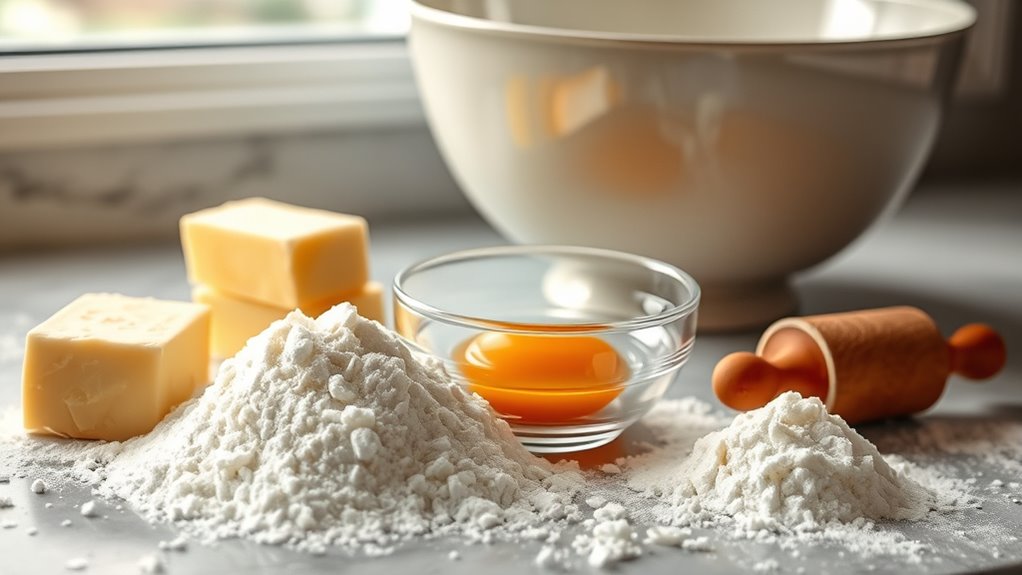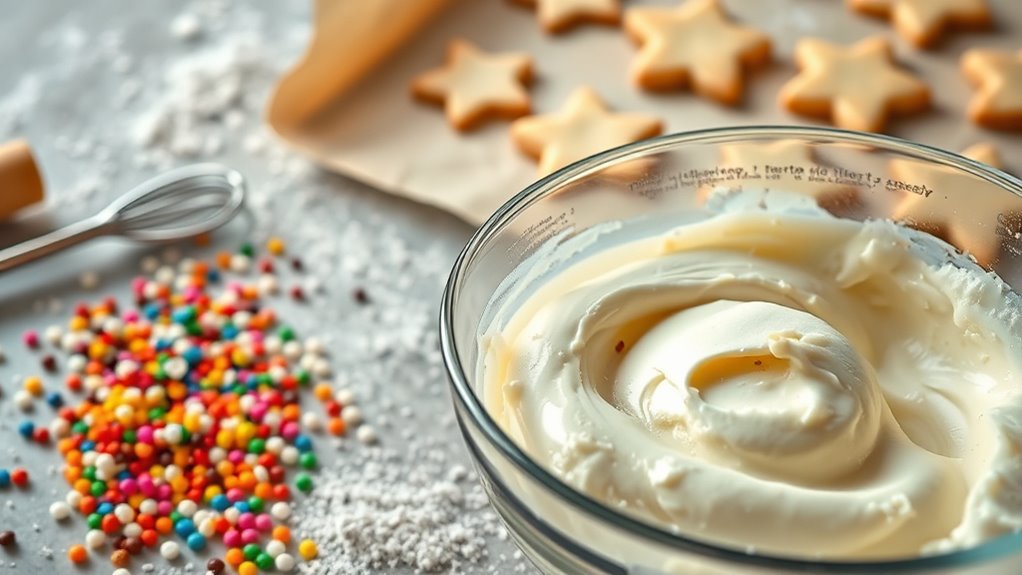You’ll want to start with basic ingredients like sifted flour, sugar, softened butter, eggs, and vanilla for perfect sugar cookies. Cream butter and sugar until fluffy, then gently fold in dry ingredients to keep the dough light. Chill the dough before rolling to control spreading and get crisp edges. Bake on parchment-lined trays for even results. Serving them at room temp enhances sweetness and texture. To master these techniques and explore flavor twists, keep following for more insights.
Ingredients and Quantity

To make perfect sugar cookies, you’ll need a precise balance of basic ingredients: flour, granulated sugar, unsalted butter, eggs, vanilla extract, baking powder, and salt. Choosing the right sugar types affects texture and sweetness, while subtle flavor variations like almond or lemon extract can elevate your cookies. Here’s a clear guide:
| Ingredient | Quantity | Notes |
|---|---|---|
| All-purpose flour | 2 ¾ cups | Sifted for lightness |
| Granulated sugar | 1 ½ cups | Can substitute with superfine for finer texture |
| Unsalted butter | 1 cup (softened) | Room temperature |
| Eggs | 2 large | Adds moisture |
Precision in these measurements releases freedom to customize flavors without sacrificing structure.
Preparations

With your ingredients measured and ready, the next step is preparing your workspace and tools for a smooth baking process. Clear your counter to create ample room for dough mixing and rolling. Line baking sheets with parchment or silicone mats to prevent sticking and guarantee even baking. Preheat your oven to the recommended temperature, allowing it to stabilize before baking. Sharpen your cookie cutters and have them within reach for precise shapes. Arrange cooling racks nearby to cool cookies evenly and avoid sogginess. If you plan on cookie decoration, set out piping bags, tips, and food coloring for efficient workflow. Mastering these baking techniques streamlines your process, giving you the freedom to focus on creativity and achieving perfect sugar cookies every time.
How to Prepare

- Start by creaming butter and sugar until light and fluffy, ensuring air is incorporated for tender cookies.
- Gradually add eggs and vanilla, mixing just until combined to avoid tough dough.
- Sift dry ingredients to prevent lumps.
- Fold dry ingredients gently into the wet mixture to maintain dough lightness.
- Chill the dough before rolling out to control spreading and achieve precise shapes.
- Roll out the dough on a floured surface to the desired thickness.
- Place cookies evenly spaced on parchment-lined baking trays to promote uniform heat distribution.
- Monitor baking times closely; remove cookies as soon as edges turn golden to retain softness.
- Master these steps to unleash creativity while maintaining perfect texture and structure every time.
How to Serve

When serving sugar cookies, presenting them at room temperature allows their delicate texture and balanced sweetness to shine, enhancing the overall tasting experience. For ideal cookie presentation, arrange them on a flat, neutral-colored platter to highlight their simplicity and let their colors pop. You can stack cookies neatly or spread them in a single layer for easy access. Serving suggestions include pairing sugar cookies with a light dip like lemon glaze or a dusting of powdered sugar for added elegance. If you want to add variety, offer a selection of flavored butters or jams on the side. Remember to keep the serving area clean and minimalistic to maintain focus on the cookies’ delicate charm, inviting your guests to savor each bite freely.
Tips

Serving sugar cookies beautifully sets the stage, but mastering a few key techniques will elevate your baking results. Start by chilling your dough; this prevents spreading and helps maintain crisp edges. Use parchment paper for even baking, and rotate your tray halfway to guarantee uniform color. When cutting shapes, dip your cutter in flour to avoid sticking. To explore flavor variations, try adding citrus zest, almond extract, or a pinch of cardamom to your dough for subtle twists. Avoid overmixing—this keeps cookies tender, not tough. For icing, pipe thin layers for precision and let each dry fully before stacking. These baking techniques give you control and freedom to customize, assuring each batch of sugar cookies is perfectly textured and bursting with your chosen flavors.
Food Value and Benefit
Sugar cookies provide a source of quick energy primarily through carbohydrates and sugars. They also contain small amounts of protein and fats from ingredients like butter and eggs, which contribute to satiety and flavor. Additionally, sugar cookies contain modest levels of vitamins and minerals such as vitamin A (from butter and eggs), calcium, and iron.
Benefits of eating sugar cookies:
- Quick energy boost from carbohydrates and sugars
- Small amounts of protein and fats help with satiety
- Contains vitamin A, which supports vision and immune function
- Provides minerals like calcium and iron important for bone health and oxygen transport
- Enjoying in moderation can satisfy sweet cravings mindfully without overindulgence
